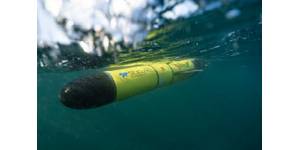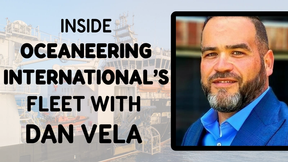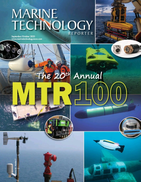Marine Technology Reporter Blogs - deepwater
Understanding ROV Launch and Recovery Systems – Part 2

The main purpose of the heavy weather launch and recovery system is to stabilize and centralize the WCROV (Work Class ROV) and Tether Management System (TMS) with a device called a cursor which restricts horizontal movement while transitioning through the air/sea interface (called the splash zone). The splash zone presents the greatest risk of damage to the WCROV, TMS, and potentially the vessel. Large waves and high winds can cause the ROV and TMS to swing wildly, potentially impacting the vessel structure. As the vehicle is raised, this motion is amplified many times, which can make it difficult if not impossible to launch/recover the WCROV in foul weather. Another hazard is the close proximity of the WCROV to vessel hull mounted thrusters during entry and exit into the splash zone.
Understanding ROV Launch and Recovery Systems – Part 1

ROV system are vital to oil and gap E&P beyond saturation diving maximum depths. Full saturation diving has been conducted to depths of nearly 600 meters (2,000 feet). Beyond this depth ROVs are employed to undertake the diver’s tasks such as opening and closing valves, construction and equipment monitoring. In order to be deployed from the surface by support vessels, ROVs must be launched, recovered, and safely and efficiently operated using dedicated systems. Two systems are needed to successfully launch, recover and operate and ROV, these are the LARS (Launch and Recovery System) and TMS (Tether Management System). ROVs may be directly deployed from a simple crane…
Pre-salt Seafloor Construction/Remote Operations Challenges Part 1

As a world leader in construction and remote operations in deep waters, Petrobras has been developing new technologies and testing them with their partners in Brazil’s deepwater pre-salt fields for over a decade. Petrobras has historically opted for an incremental strategy to develop its technological capabilities to explore the Brazil’s offshore oil resources. As deepwater discoveries began to enter the production phase, Petrobras opted for using and FPSOs and wet x-mas trees. These discoveries of supergiant oil fields in the Brazilian pre-salt have offered Petrobras an opportunity for reviewing its technological path and it is becoming clear that the national operator has been increasingly inclined to move as much of the oil production systems to the seafloor as possible…
Aker on Managed Pressure Operations

When Aker Solutions acquired Managed Pressure Operations in 2013, it became a provider of next generation continuous circulation and managed pressure drilling (MPD) systems, which has become a critical component to the drilling process going into the future. MPD systems have proven to be reliable, enabling maximum up time and significant cost savings and has been labeled of strategic importance for pre-salt drilling by Brazilian operator Petrobras, which uses MPD systems developed by Weatherford, which was the company that first introduced large scale use of the system to the industry. The MPD system being introduced by Aker/MPO is fully automated and simple to operate, needing few people to run the equipment.
AIV – Paving the way for an Autonomous Light Intervention Vehicle

When Subsea 7 and SeeByte collaborated in engineering the AIV, the world’s first purpose built Autonomous Inspection Vehicle, they were looking for a new cost-effective asset for inspecting LoF (Life of Field) projects. The AIVs software was designed to dynamically control this unique hover-capable vehicle, which is already being used in Subsea 7 LoF projects for general visual inspection. It can also be used as an aid to field survey, integrity management and developments continue, looking at expanding its use to light intervention activities. One of the advantages of the AIV over other AUV’s is its capability to hover, maintaining station when necessary. It also has the ability to operate directly from a host facility such as an FPSO or rig as well as from infield support vessels.
Water-Alternating-Gas injection

Brazil’s National Operator, Petrobras has been experimenting with advanced Water-Alternating-Gas injection in a number of offshore plays and recently at the Rio O&G 2014, Petrobras’ Pre-salt manager confirmed that the super-major will be using the technology at most, if not all of its pre-salt plays. The WAG injection process aims to recover more oil from a reservoir and also to recover oil more efficiently. The technology was originally intended to improve sweep efficiency during gas flooding, with intermittent slugs of water and gas designed by and large to follow the same route through the reservoir. Variants include injecting gas as a supplement to water or vice versa, primarily to reach other parts of the reservoir.
Deepwater Remote Operations Challenges

Today, much emphasis is given to working with real-time production data, real-time pipeline monitoring, leak detection and equipment condition monitoring. ROV/ AUV operations are used to support all sorts of deepwater seafloor construction processes, allowing operators to continuously monitor their subsea systems and intervene when necessary. Basically all equipment being installed on the seafloor has real-time communication systems, which allow operators on the surface to monitor the equipment’s performance and even control much of the equipment from the surface. Equipment that can be monitored from the surface but which cannot be manipulated remotely…
Pre-salt Seafloor Construction/Remote Operations Challenges Part 3

With the experience Petrobras has gained in deepwater field construction, the national operator has learned the best ways to get the job done and who to work with. Much of Petrobras’ deepwater seafloor construction work has been done by DOF, Technip, Subsea 7, FMC and Aker. Large deepwater post-salt fields such as Roncador, Frade and Marlim amongst others have been the main testing grounds of many construction techniques and much of the equipment being installed. Obviously, experience in deepwater seafloor construction has also been gained by Petrobras and service providers in locations such as the GoM and West Africa. Most of the pre-salt subsea trees will be built and installed by FMC, OneSubsea and Aker. FMC has a total order worth $1,5 billion, which was announced in March of 2012.
Pre-salt Seafloor Construction/Remote Operations Challenges Part 2

According to Petrobras production engineers, secondary recovery is increasingly being implemented to improve oil recovery in the pre-salt carbonates, where reservoir rocks are usually oil wet, and this characteristic affects the performance of water injection. Another problem concerning water injection is related to rock-fluid interaction, which is more important and complex in carbonates. In order to assess the risks involved, as well as to define mitigation actions, rock-fluid interaction tests are being carried out in the reservoir rock and the salt cap rock. Alternative recovery methods are being implemented in the pre-salt reservoirs.
Understanding Subsea Acoustic Leak Detection and Condition Monitoring – Part 2

In any given subsea field there is a multitude of equipment, that need to be constantly monitored. Subsea Multi-Domain Condition Monitoring can be achieved by introducing additional hydrophones, specially designed for detecting sound from rotating machinery, subsea processing equipment, structural integrity, fluid flow rate variations among others. The latest high-end sensor systems ally acoustic condition monitoring with acoustic leak detection. This works in much the same way as surface-based acoustic emission monitoring and can be used to monitor rotating machinery to check speed tracking and resonant frequencies. It can also monitor rotational equipment in subsea plant such as bearing damage, unbalanced pumps, mechanical breakdown and reduced efficiency.
Understanding Subsea Acoustic Leak Detection and Condition Monitoring – Part 1

As more and more equipment is placed on the seafloor, especially in deep waters but also in shallow waters, concerns grow over potential hydrocarbon leaks from trees, manifolds, pumps, pipelines, flowlines, risers and valves. It’s no small challenge to have a reliable subsea leak detection system that can monitor the large array of subsea systems used in modern deepwater fields and on top of that there is the need to monitor the working condition of all this equipment and others, such as ESP’s and other pumps, which are rotating equipment. Acoustic emissions are the stress waves produced by the sudden internal stress redistribution of materials caused by changes in the internal structure.
GE’s Naxys A10 – Subsea Acoustic Leak Detection

During the recent Rio O&G 2014 Expo and Conference a range of new products for the O&G industry were launched. The size of the event, with over 1,000 companies present and tens of thousands of daily visitors made it a great medium for showing new products to the market. GE had its large booth constantly full and was probably the company, which had the largest number of new products on display. Naxys joined GE in September 2012 as a world-class sensors developer for the subsea sector. With its headquarter in Bergen, Norway, Naxys develops and supplies leak detection and condition monitoring sensors based on proprietary, passive acoustic hydrophone technology.
Rio O&G 2014 – High Tech & Business for All

The last day of the Rio O&G conference began with an early morning presentation on the possible uses of Nanotechnology for O&G exploration and advanced oil recovery. The sector, with the support of IBP (Brazilian Petroleum Institute) has been working on a Nano Agent capable of increasing the average oil recovery by 20%. According to Rustom Mody, Vice-Presidente of Technology at Baker Hughes, presently 60% of nanotechnology patents are from the U.S. and Canada and the number of patents has greatly increased in the last 10 years, with the market experiencing a major growth since 2009. The market presently involves values of over US$ 9 billion, up from the US$ 4,5 billion of 5 years ago.
Rio Oil & Gas 2014 – Focus on Technology

The latest edition of the Rio O&G 2014 Expo and Conference is easily the biggest installment ever of the largest O&G event in Latin America. Many foreign participants were saying that it was the one of biggest even they’ve seen anywhere and also one of the most well organized. Praises were also lavishly handed out to the quality of the technical presentations, lectures, panels and digital poster sessions. Important developments for the industry have also been announced during the event, such as the news that Brazil’s thirteenth bidding round will take place in the first semester of 2015 and Shell’s Executive Vice President Mark Shuster’s much commented speech…
Remote Deepwater Coring and Sampling – Part 2

Helix Energy Solutions has a different concept for using an ROV in conjunction with a subsea coring and sampling rig. Helix’s system, the ROVdrill Mk. 2 actually places the ROV and the rig together inside a cage. Both the Forum Rovdrill and Helix’s ROVdrill MK. 2 are capable of deepwater operations and have their advantages and disadvantages. In this post we’ll take a look at the Helix ROVdrill MK. 2 capabilities. Helix Energy Solutions Group, Inc.’s robotics subsidiary, Canyon Offshore Limited (U.K.), which has an extensive fleet of proven trenching equipment and ROVs, also commercializes the ROVdrill Mk.2 systems. Canyon Offshore’s…
Remote Deepwater Coring and Sampling – Part 1

Compact remote methods of seabed geotechnical drilling, coring and sampling are being developed for deepwater operations and at the forefront of lightweight remote Geothechnical drilling are ROV systems combined to small drilling systems. Two companies, Forum Energy Technologies and Helix Energy Solutions, are leading the way in this technology. Forum Energy Technologies has been successfully employing its Rovdrill™ 3 system worldwide. This is Forum’s third generation Rovdrill system and it is where we will begin to look at the intricacies of these remote subsea coring and sampling systems. The advantages of taking the coring/sampling rig to the seabed are obvious, both from a technical and economic standpoint.
Deepwater Flow Assurance – Part 2

Deepwater flow assurance should always be considered from an integrated standpoint, taking into account the well, reservoir, and production angles to make sure the full range of fluid scenarios and compositions are examined, and to avoid costly resampling and re-evaluation after systems are built. Production fluids interact with the reservoir, well, pipeline, surface facilities, and the environment. All these impact flow assurance, leading to potential issues with hydrates, wax, asphaltenes, scales, slugging, emulsion, foam, sand, and corrosion. Deepwater flow assurance requires a full understanding of these interactions and a multi-disciplinary approach to managing them. Modern simulation software allows such an approach to be integrated efficiently into asset team workflows.
Deepwater Flow Assurance – Part 1

Flow assurance is a relatively new term in oil and gas industry. It refers to ensuring successful and economical flow of hydrocarbons from reservoir to the point of sale and is closely linked to multiphase flow technology. Flow Assurance developed because traditional approaches were inappropriate for deepwater production due to extreme distances, depths, temperatures or economic constraints. The term “Flow Assurance” was first used by Petrobras in the early 1990s (Garantia do Escoamento in Portuguese), meaning literally Guarantee of Flow, or Flow Assurance. Flow assurance is an extremely diverse subject, encompassing many specialized engineering disciplines.
Future ROV Technology - Subsea Wireless Control

Wireless subsea technology is becoming a fundamental part of the oil and gas industry worldwide. Back in 2010, Woods Hole Oceanographic Institution (WHOI) scientists and engineers announced testing of an undersea optical communications system that, complemented by acoustics, enabled a virtual revolution in high-speed undersea data collection and transmission. Acoustic techniques were developed, which are now the predominant mode of underwater communications between ships and smaller, autonomous and remote control vehicles. However, acoustic systems, although capable of long-range communication, transmit data at limited speeds and delayed delivery rates due to the relatively slow speed of sound in water.
Future ROV Technology - Subsea Wireless Control
Wireless subsea technology is becoming a fundamental part of the oil and gas industry worldwide. Back in 2010, Woods Hole Oceanographic Institution (WHOI) scientists and engineers announced testing of an undersea optical communications system that, complemented by acoustics, enabled a virtual revolution in high-speed undersea data collection and transmission. Acoustic techniques were developed, which are now the predominant mode of underwater communications between ships and smaller, autonomous and remote control vehicles. However, acoustic systems, although capable of long-range communication, transmit data at limited speeds and delayed delivery rates due to the relatively slow speed of sound in water.


 August 2025
August 2025



